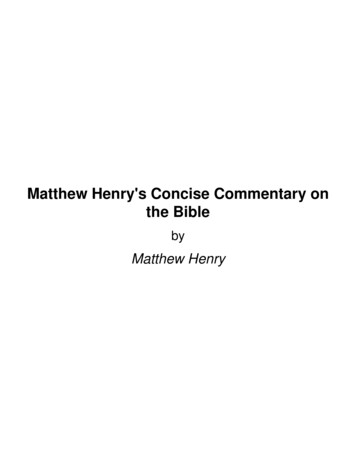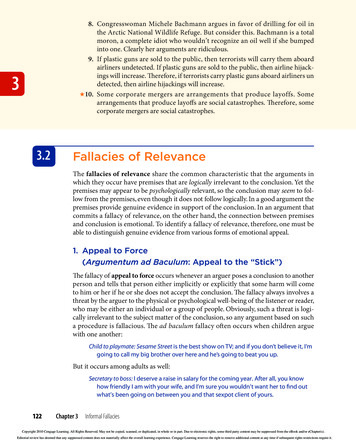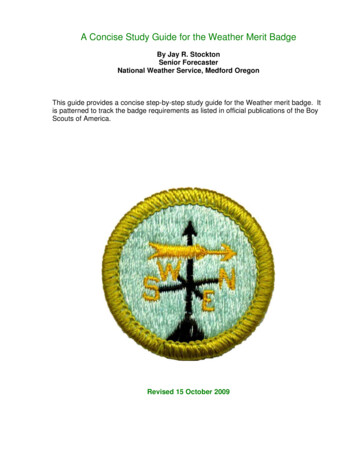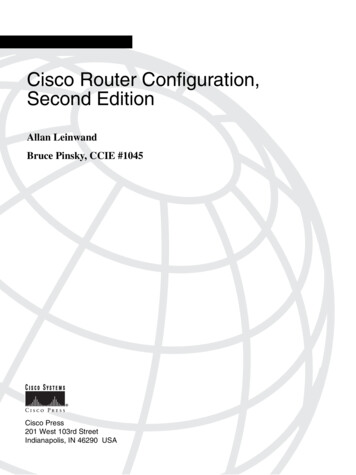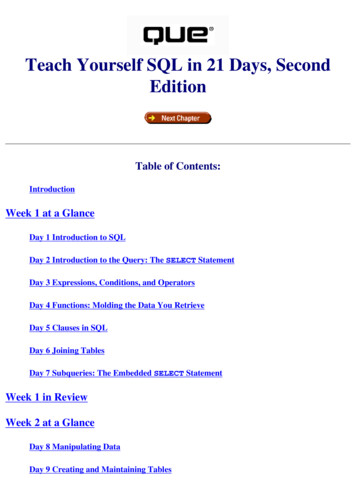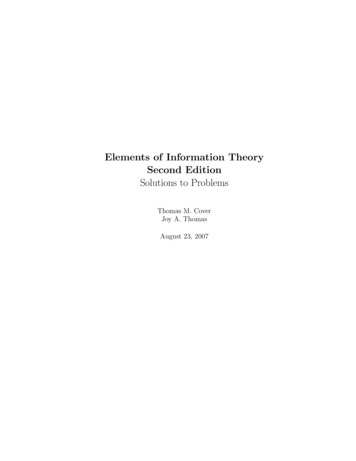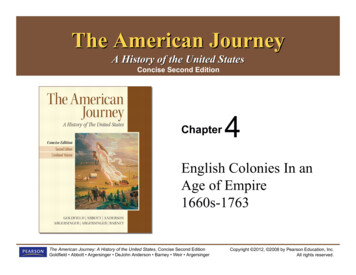
Transcription
The American JourneyA History of the United StatesConcise Second EditionChapter4English Colonies In anAge of Empire1660s-1763The American Journey: A History of the United States, Concise Second EditionGoldfield Abbott Argersinger DeJohn Anderson Barney Weir ArgersingerCopyright 2012, 2008 by Pearson Education, Inc.All rights reserved.
English Colonies In an Age of Empire1660s-1763 Economic Development and Imperial Trade inthe British Colonies The Transformation of Culture The Colonial Political World Expanding Empires A Century of Warfare ConclusionThe American Journey: A History of the United States, Concise Second EditionGoldfield Abbott Argersinger DeJohn Anderson Barney Weir ArgersingerCopyright 2012, 2008 by Pearson Education, Inc.All rights reserved.
Learning Objectives What were the goals of British tradepolicy? How did new intellectual and religioustrends reshape colonial culture? How did the “Glorious Revolution” affectcolonial politics? What was the “backcountry”? Who settledthere and why?The American Journey: A History of the United States, Concise Second EditionGoldfield Abbott Argersinger DeJohn Anderson Barney Weir ArgersingerCopyright 2012, 2008 by Pearson Education, Inc.All rights reserved.
Learning Objectives (cont'd) What role did the colonists play in theFrench and Indian War?The American Journey: A History of the United States, Concise Second EditionGoldfield Abbott Argersinger DeJohn Anderson Barney Weir ArgersingerCopyright 2012, 2008 by Pearson Education, Inc.All rights reserved.
Economic Development andImperial Trade in the BritishColoniesThe American Journey: A History of the United States, Concise Second EditionGoldfield Abbott Argersinger DeJohn Anderson Barney Weir ArgersingerCopyright 2012, 2008 by Pearson Education, Inc.All rights reserved.
The Regulation of Trade In the trade competition among Europeannations, England pursued a policy ofnational self-sufficiency based onmercantilism that used governmentintervention in the economy to increasenational wealth.The American Journey: A History of the United States, Concise Second EditionGoldfield Abbott Argersinger DeJohn Anderson Barney Weir ArgersingerCopyright 2012, 2008 by Pearson Education, Inc.All rights reserved.
The Regulation of Trade (cont'd) Government legislation required Englishships carry all imperial trade, channeledcolonial trade through England, andprovided advantages for Englishmanufacturers.The American Journey: A History of the United States, Concise Second EditionGoldfield Abbott Argersinger DeJohn Anderson Barney Weir ArgersingerCopyright 2012, 2008 by Pearson Education, Inc.All rights reserved.
The Regulation of Trade (cont'd) English trade policies succeeded and thecolonial economy expanded twice as fastas England’s did. Mercantilism- Economic system whereby the governmentintervenes in the economy for the purpose ofincreasing national wealth. Mercantilistsadvocated possession of colonies as placeswhere the mother country could acquire rawmaterials not available at home.The American Journey: A History of the United States, Concise Second EditionGoldfield Abbott Argersinger DeJohn Anderson Barney Weir ArgersingerCopyright 2012, 2008 by Pearson Education, Inc.All rights reserved.
The Regulation of Trade (cont'd) Enumerated products- Items produced in the colonies and enumerated inacts of Parliament that could be legally shippedfrom the colony of origin only to specifiedlocations, usually England and other destinationswithin the British Empire.The American Journey: A History of the United States, Concise Second EditionGoldfield Abbott Argersinger DeJohn Anderson Barney Weir ArgersingerCopyright 2012, 2008 by Pearson Education, Inc.All rights reserved.
The Colonial Export Trade and theSpirit of Enterprise The core of Anglo-American trade werestaple crops such as sugar, tobacco, rice,and indigo produced by slave labor. After1750, wheat became major colonialexport.The American Journey: A History of the United States, Concise Second EditionGoldfield Abbott Argersinger DeJohn Anderson Barney Weir ArgersingerCopyright 2012, 2008 by Pearson Education, Inc.All rights reserved.
The Colonial Export Trade and theSpirit of Enterprise New England merchants prospered bydeveloping a transatlantic trade withEngland and the West Indies. They builtthousands of ships and eventuallydominated shipping within the empire.The American Journey: A History of the United States, Concise Second EditionGoldfield Abbott Argersinger DeJohn Anderson Barney Weir ArgersingerCopyright 2012, 2008 by Pearson Education, Inc.All rights reserved.
MAP 4–1 Anglo-American TransatlanticCommerceThe American Journey: A History of the United States, Concise Second EditionGoldfield Abbott Argersinger DeJohn Anderson Barney Weir ArgersingerCopyright 2012, 2008 by Pearson Education, Inc.All rights reserved.
Scenes like this were common in the dockyards atDeptford and other parts of eighteenth-centuryLondon.The American Journey: A History of the United States, Concise Second EditionGoldfield Abbott Argersinger DeJohn Anderson Barney Weir ArgersingerCopyright 2012, 2008 by Pearson Education, Inc.All rights reserved.
The Import Trade and Ties of Credit The colonies were a major market forEnglish manufactured goods. By the late1760s, over 4 million pounds worth ofEnglish manufactured goods wereimported into the colonies. A small but significant portion of the importtrade was with Native Americans.The American Journey: A History of the United States, Concise Second EditionGoldfield Abbott Argersinger DeJohn Anderson Barney Weir ArgersingerCopyright 2012, 2008 by Pearson Education, Inc.All rights reserved.
The Import Trade and Ties of Credit(cont'd) British merchants provided easy credit,especially to planters who charged thecosts of purchases and transportationagainst future crop profits.The American Journey: A History of the United States, Concise Second EditionGoldfield Abbott Argersinger DeJohn Anderson Barney Weir ArgersingerCopyright 2012, 2008 by Pearson Education, Inc.All rights reserved.
British Imperial Trade Regulations,1651–1733The American Journey: A History of the United States, Concise Second EditionGoldfield Abbott Argersinger DeJohn Anderson Barney Weir ArgersingerCopyright 2012, 2008 by Pearson Education, Inc.All rights reserved.
Becoming More Like Britain: The Growthof Cities and Inequality The growth of commerce stimulated therise of seaport cities. Boston, Philadelphia,New York, and Charleston rivaled manyBritish provincial towns in population andhad similar cosmopolitan characters. Two out of three artisans lived in colonialcities, many laboring in trades related tooverseas commerce.The American Journey: A History of the United States, Concise Second EditionGoldfield Abbott Argersinger DeJohn Anderson Barney Weir ArgersingerCopyright 2012, 2008 by Pearson Education, Inc.All rights reserved.
Becoming More Like Britain: The Growthof Cities and Inequality (cont'd) Colonial manufacturing occurred inworkshops attached to the houses ofartisans. The workforce included otherfamily members, journeymen, andapprentices. Over time, the gap between the rich andpoor widened leading to poverty in thecities and relief efforts.The American Journey: A History of the United States, Concise Second EditionGoldfield Abbott Argersinger DeJohn Anderson Barney Weir ArgersingerCopyright 2012, 2008 by Pearson Education, Inc.All rights reserved.
The Transformation of CultureThe American Journey: A History of the United States, Concise Second EditionGoldfield Abbott Argersinger DeJohn Anderson Barney Weir ArgersingerCopyright 2012, 2008 by Pearson Education, Inc.All rights reserved.
Goods and Houses As they felt more secure economically,18th-century Americans purchased itemsto make their lives more comfortable.Among other things, chairs replacedbenches, carpets covered wooden floors,and walls featured mirrors and portraits. Prosperous colonists built grand housesthat had rooms for specialized uses suchas private bedrooms and parlors.The American Journey: A History of the United States, Concise Second EditionGoldfield Abbott Argersinger DeJohn Anderson Barney Weir ArgersingerCopyright 2012, 2008 by Pearson Education, Inc.All rights reserved.
Shaping Minds and Manners Wealthy colonists cultivated genteelmanners seeking to emulate the Englishgentry. Balls, musical performances, and fancydinners reinforced wealthy colonial beliefsthat they were a better class of peoplethan ordinary settlers.The American Journey: A History of the United States, Concise Second EditionGoldfield Abbott Argersinger DeJohn Anderson Barney Weir ArgersingerCopyright 2012, 2008 by Pearson Education, Inc.All rights reserved.
Shaping Minds and Manners (cont'd) Literacy rates were high among whitecolonists stimulating the growth ofnewspapers, almanacs, and other books. Educated colonists were especiallyinterested in Enlightenment thought, suchas Benjamin Franklin who was elected tothe Royal Society of London.The American Journey: A History of the United States, Concise Second EditionGoldfield Abbott Argersinger DeJohn Anderson Barney Weir ArgersingerCopyright 2012, 2008 by Pearson Education, Inc.All rights reserved.
Shaping Minds and Manners (cont'd) Age of Enlightenment- Major intellectual movement occurring in WesternEurope in the late seventeenth and earlyeighteenth centuries. Inspired by recent scientificadvances, thinkers emphasized the role of humanreason in understanding the world and directingits events. Their ideas placed less emphasis onGod’s role in ordering worldly affairs.The American Journey: A History of the United States, Concise Second EditionGoldfield Abbott Argersinger DeJohn Anderson Barney Weir ArgersingerCopyright 2012, 2008 by Pearson Education, Inc.All rights reserved.
By the time he was in his forties, BenjaminFranklin had already achieved considerablefame as an author, scientist, and inventor.The American Journey: A History of the United States, Concise Second EditionGoldfield Abbott Argersinger DeJohn Anderson Barney Weir ArgersingerCopyright 2012, 2008 by Pearson Education, Inc.All rights reserved.
Colonial Religion and the GreatAwakening In New England, religion remained at thecore of society and had accommodatedchanging attitudes through the HalfwayCovenant that eased baptismrequirements. In the South, the Congregational Churchconsolidated its authority in the early1700s.The American Journey: A History of the United States, Concise Second EditionGoldfield Abbott Argersinger DeJohn Anderson Barney Weir ArgersingerCopyright 2012, 2008 by Pearson Education, Inc.All rights reserved.
Colonial Religion and the GreatAwakening (cont'd) Halfway Covenant- Plan adopted in 1662 by New England clergy todeal with the problem of declining churchmembership. It allowed adults who had beenbaptized because their parents were churchmembers but who had not yet experiencedconversion to have their own children baptized.Without the Halfway Covenant, these thirdgeneration children would remain unbaptized untiltheir parents experienced conversion.The American Journey: A History of the United States, Concise Second EditionGoldfield Abbott Argersinger DeJohn Anderson Barney Weir ArgersingerCopyright 2012, 2008 by Pearson Education, Inc.All rights reserved.
Colonial Religion and the GreatAwakening (cont'd) Great Awakening- Tremendous religious revival in colonial America.Sparked by the tour of the English evangelicalminister George Whitefield, the Awakening struckfirst in the Middle Colonies and New England inthe 1740s and eventually spread to the southerncolonies by the 1760s. New Lights- People who experienced conversion during therevivals of the Great Awakening.The American Journey: A History of the United States, Concise Second EditionGoldfield Abbott Argersinger DeJohn Anderson Barney Weir ArgersingerCopyright 2012, 2008 by Pearson Education, Inc.All rights reserved.
The Colonial Political WorldThe American Journey: A History of the United States, Concise Second EditionGoldfield Abbott Argersinger DeJohn Anderson Barney Weir ArgersingerCopyright 2012, 2008 by Pearson Education, Inc.All rights reserved.
The Dominion of New England and theLimits of British Control Before 1650, England made little effort toexert centralized control over its NorthAmerican colonies. King James II attempted to tighten imperialcontrol by combining the colonies intolarger provinces, starting with theDominion of New England.The American Journey: A History of the United States, Concise Second EditionGoldfield Abbott Argersinger DeJohn Anderson Barney Weir ArgersingerCopyright 2012, 2008 by Pearson Education, Inc.All rights reserved.
The Dominion of New England and theLimits of British Control (cont'd) The Glorious Revolution ended theDominion practice but led to changes inthe territory and governance of somecolonies. For example, Massachusettsexpanded to include Plymouth and Maine,and a new charter ended exclusive Puritancontrol.The American Journey: A History of the United States, Concise Second EditionGoldfield Abbott Argersinger DeJohn Anderson Barney Weir ArgersingerCopyright 2012, 2008 by Pearson Education, Inc.All rights reserved.
The Dominion of New England and theLimits of British Control (cont'd) Dominion of New England- James II’s failed plan of 1686 to combine eightnorthern colonies into a single large province, tobe governed by a royal appoi
Goldfield Abbott Argersinger DeJohn Anderson Barney Weir Argersinger Goods and Houses As they felt more secure economically, 18th-century Americans purchased items to make their lives more comfortable. Among other things, chairs replaced benches, carpets covered wooden floors, and walls featured mirrors and portraits.
![Fluent Python : [clear, concise, and effective programming]](/img/1/799981060.jpg)
